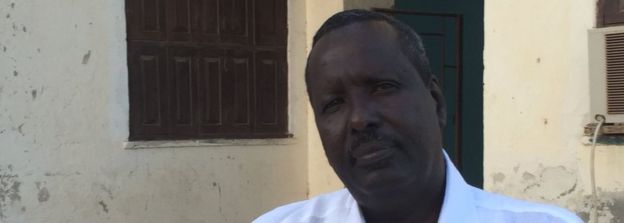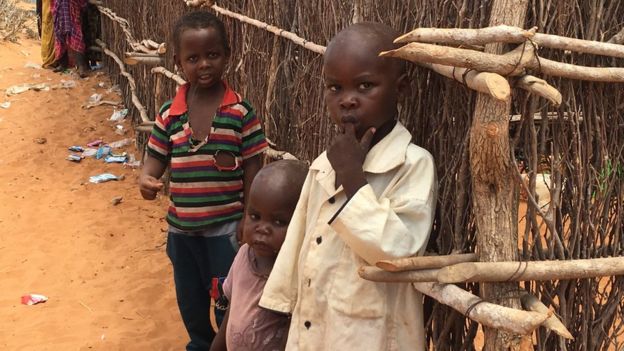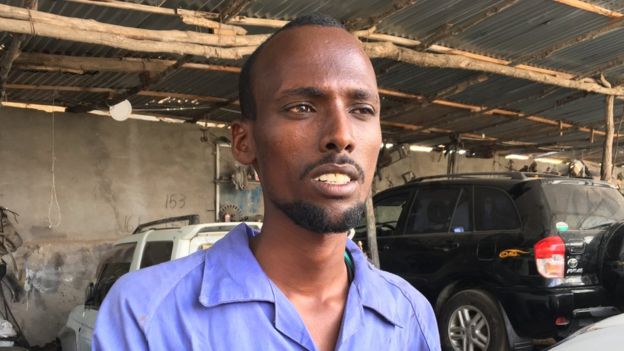Kenya's announcement that Dadaab, the world's largest refugee camp, would close at the end of this month has encouraged thousands of people to leave already, but without further preparation, it seems unlikely the government will be able to meet its own deadline, which has been condemned by human rights groups.
Small shacks of wood, corrugated iron and scraps of tarpaulin cling to the sand dunes on the outskirts of Somalia's southern port city of Kismayo.
Tens of thousands of people displaced by drought and decades of civil war live in 86 camps around Kismayo alone.
And thousands more have been arriving in Somalia in the months since Kenya said it would close down Dadaab, the world's largest refugee camp.
At the height of the fighting and the famine in Somalia, Dadaab, with its sprawling stretch of refugee camps in the flat, dusty desert scrubland of north-eastern Kenya, was home to half a million people.
Today 280,000 receive help with food and shelter, healthcare and education, but Kenya says 25 years is long enough, and the camp must close by the end of this month.
Some have been flown back by the United Nations refugee agency (UNHCR), others have been brought by bus through Somali countryside still controlled by the Islamist militant group al-Shabab.

Somalia is still riven by clan divisions and regional political rivalries, and is only slowly stuttering towards becoming a functioning federal state.
"We need our people to come back, but the problem is how they can stay here, get a livelihood and how we can support them," said General Mohamed Warsmae Darwish, interior minister for the southern state of Jubaland which has Kismayo as its capital.
"People have no toilets, no shelter, no water, no education, no medicine - how can they cope?" he said.
There are already tens of thousands of people living in camps for the displaced in Somalia, where aid agencies struggle to provide help and the new arrivals are increasing the pressure.
Mariam Ibrahim Mohammed arrived just a few weeks ago from Dadaab with her four children.
"Given the choice between here and Dadaab, I'd rather have stayed in Dadaab," she said.
"Since I came back, I have not been given anything. The money they gave us when we left has already been spent. Life is very difficult here, but I can't go back."
Some call Dadaab a desert city, others an open prison, but pulling down a place where many of its inhabitants were born and have never left takes time and must be done within the bounds of international humanitarian law.
"The closure of Dadaab is the decision that the refugees themselves will reach if and when they want to return," said Mohamad Abdi Affey, the new United Nations special envoy for Somali refugees.
"If people want to come back to their country and need help, it is our mandate to help them, but we are not an advocate of return by any means."
But the UN has been criticised for not doing enough to tell people they have the right to stay - whatever the Kenyan government says about closing Dadaab.
There is a small, sparsely furnished office in a UNHCR compound where refugees come to find out more about voluntary returns.
Falahas Mahila and her six children listen to what's on offer: $200 (£160) per family member when they leave, the same again when they get home, plus other grants to buy housing materials, healthcare or to pay towards education.
This amount has recently been increased, and it's a lot of money for people who have lived as refugees for so long, surviving on aid and assistance.

She is convinced Kenya is going to close the camp, and there are many rumours that if they don't take the money now, they may be forced to leave anyway with nothing.
The UN says around 25,000 people have signed up to go home, but the uncertainty over their future is further complicated by Jubaland's decision to close its border to returnees until it has the facilities to cope.
The returns have been suspended. Some refugees have sent their possessions on ahead and sold off their makeshift homes, leaving them in limbo.
Duh Ali Hanshi has a fence of thorn branches surrounding her little patch of land and small wood and tarpaulin home.
She fled the fighting in Somalia six years ago and says she doesn't want to leave because it's not safe, and at least here there is health care and education.
"We were told there's an instruction coming from the Kenya government that we have to go back," she said.
"I have children in school and I want them to continue with their education here, but right now we are living in fear. We don't know whether to go back to Somalia or to stay here. We will have to go back if we must go back."
Twenty-five years is a long time for any country to host hundreds of thousands of refugees, but with an election next year and fears of al-Shabab infiltration, there is a large dose of politics surrounding Kenya's decision to close the camp.
But there are fears that it could encourage the very thing Kenya is most afraid of - radicalisation.
Back in Kismayo, a group of young apprentice mechanics are learning how to repair an engine.

Most of them are recent returnees from Dadaab, sharing work and training programmes with those who have lived in camps around the city for years.
Mohamed Ali Abdi, 28, came back eight months ago.
"When I left Dadaab it was my decision - there was a little bit of pushing - but I always wanted to come back to my country," he said.
But he understands the dangers of not providing young people with work.
"It's very possible that if the young men coming back from Dadaab are not given help by the government or aid agencies they could be recruited into al-Shabab."
It's complicated - people can't remain as refugees forever, but how will a camp ever close if it offers people more than they would get at home?
How can they return when security is still a major concern and when increasing the number of poor and dependent people jeopardises Somalia's fragile recovery - the long-term answer to the problem.
It seems the only way to close Dadaab is slowly, and that means Kenya will almost certainly have to backtrack on its plan to close Dadaab by the end of this month.
BBC
No comments:
Post a Comment